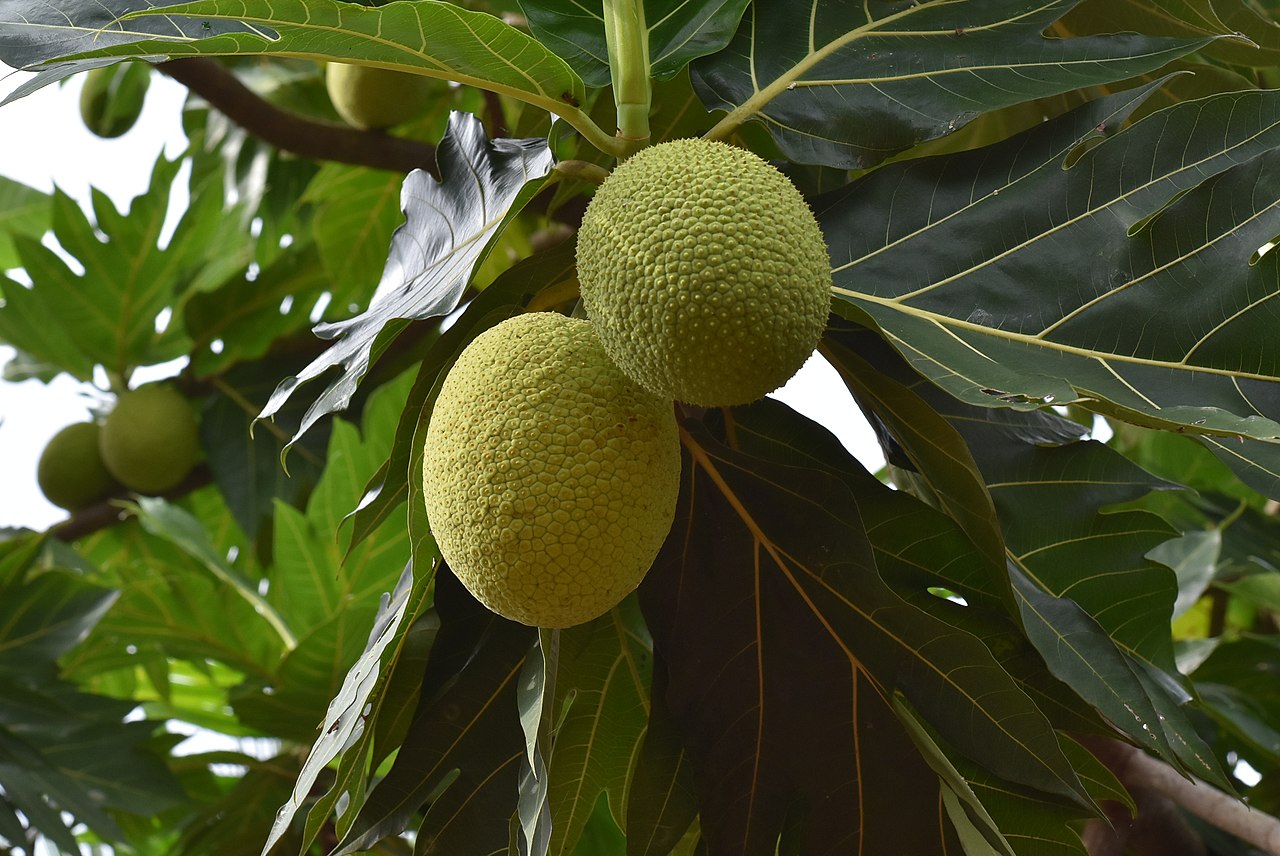Artocarpus altilis.

|
|
Artocarpus altilis Common Names: Breadfruit, Breadnut, Ulu
Species ID: NMP-010 | wfo-0000550425, NCBI:txid194251 Scientific
Classification Kingdom: Plantae Phylum: Tracheophyta Class: Magnoliopsida Order: Rosales Family: Moraceae Genus: Artocarpus Species: A. altilis Synonyms: Artocarpus altilis var. non-seminiferus (Duss) Fournet, Artocarpus altilis var. seminiferus (Duss) Fournet, Artocarpus communis J.R.Forst. & G.Forst., Artocarpus incisifolius Stokes, Artocarpus incisus (Thunb.) L.f., Artocarpus laevis Hassk., Artocarpus papuanus Diels, Artocarpus rima Blanco, Radermachia incisa Thunb., Saccus laevis Kuntze, Sitodium altile Parkinson ex F.A.Zorn Morphological Description Artocarpus altilis, commonly known as breadfruit, is a large evergreen tree,
typically growing 15–30 m tall, with a broad, spreading canopy up to 20 m wide.
Its key features include: · Stem: Trunk straight, up to 1 m in diameter, with greyish-brown
bark exuding white latex when cut · Leaves: Large, alternate, deeply lobed, 20–90 cm long, 20–50 cm
wide, glossy dark green, leathery, with pubescent undersides · Flowers: Monoecious, with male flowers in cylindrical spikes (15–25
cm long) and female flowers in globular heads · Fruit: Round to oblong, 10–30 cm in diameter, 0.5–2 kg, green to
yellowish, with smooth, warty, or spiky skin; starchy white flesh, bread-like
when cooked Distribution and Habitat Artocarpus altilis likely originated in New Guinea and the Indo-Malay region,
domesticated in Polynesia from the seeded Artocarpus camansi. Spread by
Austronesian voyagers 3,000 years ago, it reached Oceania, and European
colonial efforts in the 18th century introduced it to the Caribbean, Central
America, Africa, and Southeast Asia. It is now cultivated in over 90 countries,
including Nigeria, Ghana, and the Philippines. It thrives in: · Ecosystems: Tropical forests, coastal lowlands, and cultivated
plantations · Climate: Tropical, with rainfall of 1,500–3,000 mm annually and
temperatures of 21–32°C · Soils: Well-drained, fertile, loamy to sandy, pH 6.0–7.5 · Altitude: Sea level to 1,500 m In Nigeria, it is grown
in southern states like Ogun and Delta, often in mixed agroforestry systems. Ethnopharmacology Artocarpus altilis, commonly known as breadfruit, is a medicinal and nutritional
plant traditionally used in tropical regions. Various parts of the
plant including the leaves, fruits, bark, and latex are known for their
antimicrobial, anti-inflammatory, antioxidant, antidiabetic, and wound-healing
properties. Traditionally, leaf extracts are used to manage high blood pressure,
diabetes, liver disorders, and skin infections, while the latex is applied to
treat skin wounds, fungal infections, and inflammations. The fruit itself is
highly nutritious and often used to boost digestive health and support immune
function. Phytochemical studies have identified active compounds such as
flavonoids, tannins, phenolic compounds, and terpenoids, which contribute to
its medicinal effects. While Artocarpus altilis is valued for both its health
benefits and nutritional richness, more clinical studies are needed to
comprehensively validate its therapeutic applications and determine
standardized dosages. · Antioxidant
Activity: Extracts from
Artocarpus altilis have demonstrated significant antioxidant properties,
attributed to the presence of phenolic compounds such as flavonoids. These
compounds help in scavenging free radicals and reducing oxidative stress
(Soifoini et al., 2021). · Antimicrobial
Activity: Studies have
shownongoing conversation that A. altilis extracts possess antimicrobial properties
against various bacterial and fungal pathogens, supporting its traditional use
in treating infections (Raju et al., 2017). · Anti-inflammatory
Activity: Ethanol extracts of A. altilis
leaves exhibited anti-inflammatory effects by inhibiting the production of
pro-inflammatory mediators in LPS-induced RAW 264.7 cells (Fitrya et al.,
2023). · Cytotoxic
Activity: Methanol extracts of A.
altilis fruit showed cytotoxic effects against MCF-7 breast cancer cells,
indicating potential anticancer properties (Jalal et al., 2022). · Cardioprotective Effects: Aqueous
leaf extracts reduced heart rate and infarct size in isoproterenol-induced
myocardial injury in rats, validating their use for hypertension and heart
conditions in Jamaica (Nwokocha et al., 2017;). · Insect Repellent and Antiparasitic: Crushed leaves repelled mosquitoes. · Photoprotective Effects: Heartwood
extracts containing artocarpin suppressed UVB-induced skin damage in mice by
reducing MMP-1 and pro-inflammatory cytokines (TNF-α, IL-6), validating their
use for skin disorders in Southeast Asia (Tiraravesit et al., 2015;). ⚠ Toxicity Profile: Artocarpus altilis is generally safe when cooked, but raw
fruit may cause nausea and bloating due to high starch content. The milky latex
can cause contact dermatitis in sensitive individuals. Toxicological
evaluations have indicated that A. altilis extracts are generally safe. In
acute toxicity studies, no mortality or significant toxic reactions were
observed in experimental animals at doses up to 2000 mg/kg body weight (Sairam
& Urooj, 2014). Additional Uses · Culinary: The starchy fruit is roasted, boiled, fried, or processed
into flour, chips, or fermented products like poi in Hawaii and ginataang rimas
in the Philippines. Seeds are roasted as snacks in Nigeria. · Timber: The lightweight, termite-resistant wood is used for
construction, furniture, and canoe building in Polynesia and Nigeria. · Agroforestry: The tree’s canopy provides shade for crops like cocoa, and
its roots stabilize soil in Caribbean plantations. · Animal Feed: Leaves and overripe fruits are used as fodder for livestock
in Ghana. References
External Links More Pictures |
|
| Compounds of Artocarpus altilis. |
|
| References |